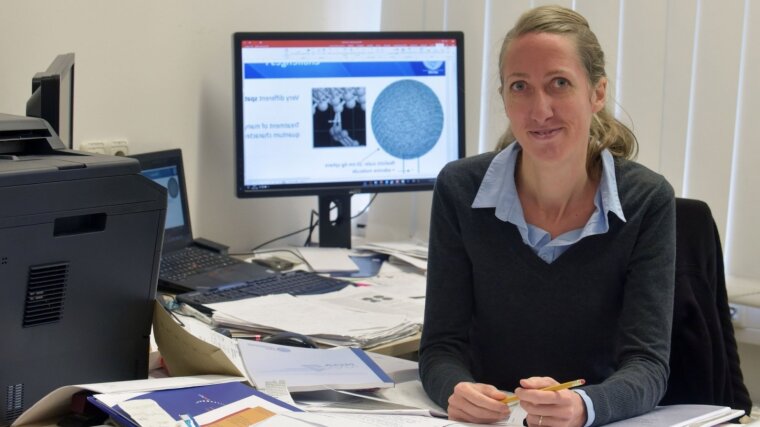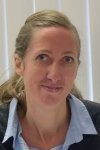
Prof. Gräfe has joined the Friedrich Schiller University Jena in 2013 and is the head of the Theoretical Chemistry group at the Institute for Physical Chemistry. Based on her research in strong field molecular physics, she is also associated with the Faculty of Physics and Astronomy.
The Theoretical Chemistry group examines structural, electronic and spectroscopic properties of atoms, molecules, surfaces and other quantum systems with the help of quantum chemical methods. Strong emphasis lies on the theoretical description and modeling of processes involving the interaction of weak and intense ultrashort laser pulses with molecular systems. Concerning weak-laser - matter interaction, we focus our attention to the simulation of electronic and energy transfer processes of light-harvesting or other excitonic systems. For strong-field processes, we examine the interaction of intense, ultrashort laser pulses with atoms and molecules leading to ultrafast internal, ionization and fragmentation dynamics of these systems. The Theoretical Chemistry group closely collaborates with several groups within the Abbe Center of Photonics and other world-leading experimental groups in these research fields.
Research Areas
Prof. Gräfe’s research covers a wide range of topics in quantum chemistry and molecular dynamics with strong emphasis on the theoretical description and modeling of processes involving the interaction of weak and intense ultrashort laser pulses with atomic, molecular and other quantum systems:
- Strong-field atomic and molecular physics
- Femtosecond chemistry and attosecond physics
- Time-resolved spectroscopy
- Photophysics of electron transfer systems
- Electronic and spectroscopic properties of molecular systems
- Quantum chemistry
Teaching Fields
Prof. Gräfe is teaching basic and advanced topics of physical and theoretical chemistry for both undergraduate and graduate students. She aims at introducing students to modern research areas and supporting their education towards young researchers. Current topics include:
- Quantum mechanics and molecular dynamics
- Theoretical and quantum chemistry
- Light-matter interaction
- Symmetry and chemistry
Research Methods
The research group lead by Prof. Gräfe applies state-of-the-art quantum chemical methods and develops numerical schemes to describe various aspects of light-matter interaction:
- Numerical solution of the time-dependent Schrödinger equation
- Non-adiabatic (quantum and classical ) dynamics
- Time-dependent density functional theory (TD-DFT)
- Ab-initio quantum chemistry
Recent Research Results
Our research activities have been focused on the theoretical description and simulation of ultrafast internal, ionization and fragmentation dynamics of atomic and molecular systems in intense and ultrashort laser fields.
Strong-field physics and chemistry:
While in the last decades strong field physics was mainly focused on atoms and small diatomic molecules, now also larger and chemically more interesting molecules are increasingly investigated. In these strong laser fields, ionization and fragmentation dynamics play an important role besides rotational dynamics. It is a great challenge for theoretical modeling to describe the interaction of polyatomic molecules with intense laser fields completely numerically, because many degrees of freedom on many different temporal and spatial scales are involved. For the theoretical description, we pursue different approaches, from multi-physics approaches to quantum and/or (semi-)classical dynamics. This way, we are able to describe the ionization of triatomic and pro-chiral molecular systems [1], the complex strong-field dynamics of HeH+ [2], or the symmetry breaking (Renner-Teller effect) of CS2 in strong fields [3, 4]. Our group often works in close collaboration with experimental groups. Locally, we collaborate with the group of Prof. Gerhard Paulus.
Molecular-plasmonic hybrid systems:
Novel hybrid materials of metallic nanoparticles and organic molecular aggregates offer one of the most versatile architectures for the design and implementation of functionality at the nanoscale. These hybrid materials combine the light collection properties of the aggregates with the fast and efficient charge transfer dynamics of nanoparticles and are therefore very good as model systems for e.g. dye sensitized solar cells and artificial photosynthesis complexes. We are developing methods to investigate for the first time the interaction of the excitonic dynamics of the aggregates with the plasmonic dynamics of the nanoparticles. Recently, we have started to investigate the “chemical effects” in molecule-nanoparticle hybrid systems interacting with external laser fields, which are the result of the close proximity of the metallic nanoparticle and the molecule. To this end, we simulated the experimental setup of tip-enhanced Raman scattering (TERS) and calculated the influence of the relative position of the metallic tip to the sample molecule on the molecular properties and thus on the spectroscopic observables using quantum chemical methods [5]. We found that the presence of a single Ag atom (or a small Ag cluster) leads to strong changes in the Raman spectrum. Together with electrodynamic calculations, our calculations provide an indication as to why a TERS setup allows experimental (sub-)nanometer resolution [6].
[1] Paul et al., Phys. Rev. Lett. 120, 233202 (2018).
[2] Wustelt et al., Phys. Rev. Lett. 121, 073203 (2018).
[3] Wolter et al., Proc. Natl. Acad. Sci. 116, 8173 (2019).
[4] Wolter et al., Science 354, 308 (2016).
[5] Latorre et al., Nanoscale 8, 10229 (2016).
[6] Fiederling et al., Nanoscale, 12, 6346 (2020).
link to the Gräfe group at the Institute of Physical Chemistry de
link to the SFB 1375 "NOA - Nonlinear Optics down to Atomic scales"
